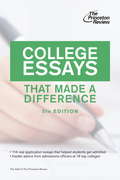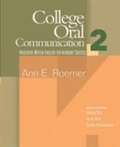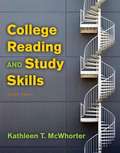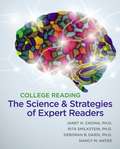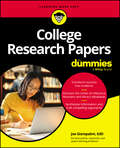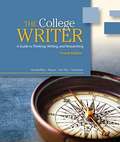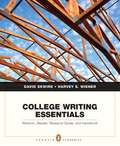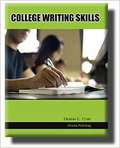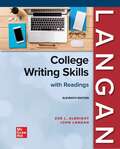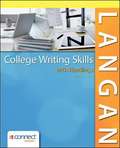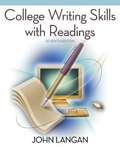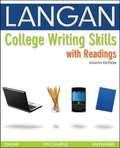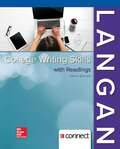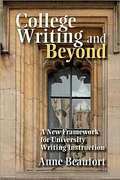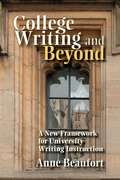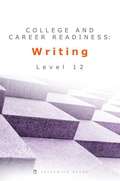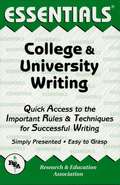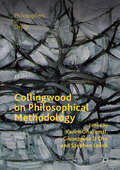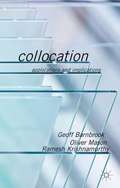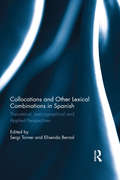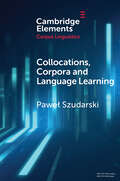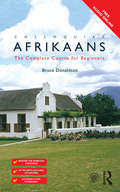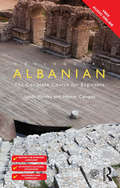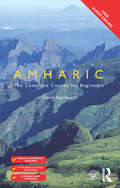- Table View
- List View
College Essays that Made a Difference, 5th Edition
by Princeton ReviewNot sure how to tackle the scariest part of your college application--the personal essays? Get a little inspiration from real-life examples of successful essays that scored! In this 5th edition of College Essays that Made a Difference, you'll find:* 114 real essays written by 90 unique college hopefuls applying to Harvard, Princeton, Stanford, Yale, MIT, and other top schools--along with each applicant's test scores, GPA, demographic information, and where they ultimately got in* A special section with writing tips and the most common grammatical mistakes that students make on their essays* Insider advice from with admissions pros at Amherst College, Cooper Union, Deep Springs College, Franklin W. Olin College of Engineering, Johns Hopkins University, Macalester College, University of North Carolina--Chapel Hill, University of Virginia, Yale University, and moreThis fifth edition includes application essays written by students who enrolled at the following colleges:Amherst CollegeBard CollegeBarnard CollegeBoston CollegeBrown UniversityBryn Mawr CollegeCalifornia Institute of TechnologyClaremont McKenna CollegeCornell UniversityDartmouth CollegeDuke UniversityFranklin W. Olin College ofEngineeringGeorgetown UniversityHarvard CollegeMassachusetts Institute ofTechnologyMiddlebury CollegeNew College of FloridaNew York UniversityNorthwestern UniversityPomona CollegePrinceton UniversityRice UniversitySmith CollegeStanford UniversitySwarthmore CollegeUniversity of California--San DiegoUniversity of Notre DameUniversity of PennsylvaniaWashington and Lee UniversityWellesley CollegeWesleyan UniversityYale University
College Oral Communications
by Ann E. RoemerThe Houghton Mifflin English for Academic Success series is a comprehensive program of student and instructor materials: four levels of student language proficiency textbooks in three skill areas (oral communication, reading, and writing), with supplemental vocabulary textbooks at each level. For instructors and students, a useful website supports classroom teaching, learning, and assessment. For instructors, four Essentials of Teaching Academic Language books (Essentials of Teaching Academic Oral Communication, Essentials of Teaching Academic Reading, Essentials of Teaching Academic Writing, and Essentials of Teaching Academic Vocabulary) provide helpful information for instructors new to teaching oral communication, reading, writing, and vocabulary. The fundamental purpose of the series is to prepare students who are not native speakers of English for academic success in U.S. college degree programs. By studying these materials, students in college English for Academic Purposes (EAP) courses will gain the academic language skills they need to be successful students in degree programs. Additionally, students will learn about being successful students in U.S. college courses. The series is based on considerable prior research, as well as our own investigations of students' needs and interests, instructors' needs and desires, and institutional expectations and requirements. For example, our survey research revealed what problems instructors feel they face in their classrooms and what they actually teach; who the students are and what they know and do not know about the "culture" of U.S. colleges; and what types of exams are required for admission at various colleges. (Taken From Book)
College Reading and Study Skills
by Kathleen T. Mcwhorter Brette M. SemberCollege Reading and Study Skills teaches reading, critical thinking and study skills for today's diverse students, encouraging them to apply these integrated skill sets to their coursework and future academic success. Kathleen McWhorter wrote College Reading and Study Skills, primarily, for courses that are half reading, half study skills. Emphasizing comprehension and metacognition, College Reading and Study Skills approaches reading and study skills as essential skills necessary for college success. The text focuses on reading and learning as a cognitive process, encouraging students to approach reading as an active mental process of selecting, processing, and organizing information to be learned.
College Reading: The Science And Strategies Of Expert Readers
by Janet Nay Zadina Rita Smilkstein Deborah Daiek AnterCOLLEGE READING: THE SCIENCE AND STRATEGIES OF EXPERT READERS approaches reading from a thinking skills perspective by explaining how we think, learn, and read. This expert group of authors credibly incorporates widely proven brain research and learning theory into a user-friendly dynamic reading textbook aimed at diverse learners. The bridge from the scientific research to the classroom is carefully crafted so that not only will students learn to read more efficiently, but they will also learn how to learn more efficiently. By explaining the brain science of reading, COLLEGE READING empowers students with the knowledge that they can change their brain into a more effective reading brain. COLLEGE READING teaches students how to read by providing interactive learning and reading opportunities--Making Connections, Brain Connections, Activities, Practice with a Reading Passage, Post Test, and Brain Strength Options--so that students are discovering, understanding, and remembering essential reading skills they can apply to their future coursework. All students can be naturally motivated, expert readers and learners with COLLEGE READING. Available with InfoTrac Student Collections http://gocengage. com/infotrac.
College Research Papers For Dummies
by Joe GiampalmiGet ready to take on your first college research paper like a pro Just got assigned your first college research paper? Don’t sweat it! College Research Papers For Dummies has your back with the perfect companion to these not-as-hard-as-they-look assignments. Discover how to research, argue, problem-solve, analyze, and synthesize your way through even the densest material. Find out how to best revise and rework your paper until it’s a polished gem. Plus, get some quick tips on higher-level research papers, such as literature reviews and white papers. Accurately cite references using APA, MLA, and Chicago styles Take advantage of all the resources available to you as you write your first research paper, from your university’s library databases to your local college center’s support services Develop common research paper writing techniques, including argumentation, research questions, and thesis statements Don’t wait until the night before your paper is due! Grab a copy of College Research Papers For Dummies today and ace that first research paper like we all know you can.
College Writer: A Guide to Thinking, Writing, and Researching
by Patrick Sebranek Verne Meyer Randall Vandermey John Van RysCombining streamlined basic writing instruction with outstanding accessibility, THE COLLEGE WRITER is a fully updated four-in-one text--with a Rhetoric, a Reader, a Researcher, and a Handbook--for students at any skill level. The clear visual "at-a-glance" format helps students grasp larger concepts by linking them to pertinent examples. Throughout the text, numerous student and professional writing samples highlight important features of academic and career writing--from using the appropriate voice to incorporating references--and offer models for students' own papers.
College Writing Essentials: Rhetoric, Reader, Research Guide, and Handbook
by David Skwire Harvey S. WienerThe first brief rhetorically-organized writing guide of its kind, College Writing Essentials: Rhetoric, Readings, Research Guide and Handbook presents comprehensive coverage of the six most frequently taught modes. Provides writing instruction in a brief, rhetorically-organized guide. Rhetorical modes, research, literary analysis and handbook.
College Writing For Dummies
by Joe GiampalmiTransform your next college essay into an A+ masterpiece Taking a 100-level English composition course? Just doing your best to get ready for the rigors of college-level writing? Then it&’s probably time you picked up College Writing For Dummies, the single greatest roadmap to writing high-quality essays, reports, and more! This book is the ideal companion for any introductory college writing course and tracks the curriculum of a typical English Composition, College Writing, English 101, or Writing & Rhetoric course. You&’ll learn composition techniques, style, language, and grammar tips, and discover how to plan, write, and revise your material. You&’ll also get: Ten can&’t-miss resources for improving your college writing Strategies for revising and repairing inadequate essays on your own Techniques to help non-native English speakers master the challenging world of English essay writingFull of real-world examples, lessons in essay structure, grammar, and everything in between, this book is a must-read for every incoming college freshman looking for a head start in one of the most important skills you&’ll need over the next few years. Grab a copy of College Writing For Dummies today.
College Writing Skills With Readings
by John Langan Zoe L. AlbrightCollege Writing Skills with Readings, 11th edition, emphasizes writing skills as well as process. By identifying a set of 4 fundamental skills critical to effective writing, College Writing Skills with Readings encourages students to see writing as a skill that can be learned and a process that must be explored. These 4 skills, or bases, for effective writing are as follows: Unity: Discover a clearly stated point, or topic sentence, and make sure that all other information in the paragraph or essay supports that point. Support: Support the points with specific evidence, and plenty of it. Coherence: Organize and connect supporting evidence so that paragraphs and essays transition smoothly from one bit of supporting information to the next. Sentence skills: Revise and edit so that sentences are error-free for clearer and more effective communication. These four bases are essential to all effective writing, whether it be a narrative paragraph for a personal journal, a cover letter for a job application, or an essay for an academic assignment.
College Writing Skills with Readings
by John LanganGrounded in John Langan's Four Bases - unity, coherence, sentence skills, and support - College Writing Skills with Readings employs a unique personalized learning plan to address student deficits in grammar and mechanics and to free instructional time for activities emphasizing writing process and critical thinking. From mastering the traditional five-paragraph essay and its variations to learning about the finer points of grammar and punctuation, College Writing Skills with Readings empowers students to think more deeply about audience and purpose as they write for college and career. This new ninth edition provides a greater balance focus on personal, academic, and workplace writing.
College Writing Skills with Readings (7th edition)
by John LanganJohn Langan's College Writing Skills with Readings, Seventh Edition, focuses on the essay using Langan's renowned clear writing style, as well as his wide range of writing assignments and activities that reinforce the four bases of effective writing: unity, support, coherence, and sentence skills. For the new seventh edition, John Langan has added a variety of fresh elements to his proven approach.
College Writing Skills with Readings (8th edition)
by John LanganThis text offers students a practical guide to becoming better writers. From mastering the traditional five-paragraph essay and its variations to learning about the finer points of grammar and punctuation, the book empowers students to take control of their writing and put it to work for them.
College Writing Skills, With Readings
by John Langan Zoe L. AlbrightCollege Writing Skills with Readings 10e highlights the importance of writing with a purpose by focusing on four bases of writing: unity, support, coherence, and sentence skills. The four bases provide students with clear guidance on how to organize their thoughts, structure their main idea into a thesis, provide supporting evidence to their claim, and revise and edit their work into a well complete, composed essay. College Writing Skills with Readings personalizes and grounds students’ writing experience by placing all of its reading, writing, and essay examples within three key realms - personal, academic, and workplace (PAW) - to emphasize the importance of writing in every facet of life.
College Writing and Beyond
by Anne BeaufortComposition research consistently demonstrates that the social context of writing determines the majority of conventions any writer must observe. Still, most universities organize the required first-year composition course as if there were an intuitive set of general writing "skills" usable across academic and work-world settings. In College Writing and Beyond: A New Framework for University Writing Instruction, Anne Beaufort reports on a longitudinal study comparing one student's experience in FYC, in history, in engineering, and in his post-college writing. Her data illuminate the struggle of college students to transfer what they learn about "general writing" from one context to another. Her findings suggest ultimately not that we must abolish FYC, but that we must go beyond even genre theory in reconceiving it. Accordingly, Beaufort would argue that the FYC course should abandon its hope to teach a sort of general academic discourse, and instead should systematically teach strategies of responding to contextual elements that impinge on the writing situation. Her data urge attention to issues of learning transfer, and to developmentally sound linkages in writing instruction within and across disciplines. Beaufort advocates special attention to discourse community theory, for its power to help students perceive and understand the context of writing.
College Writing and Beyond: A New Framework for University Writing Instruction
by Anne BeaufortComposition research consistently demonstrates that the social context of writing determines the majority of conventions any writer must observe. Still, most universities organize the required first-year composition course as if there were an intuitive set of general writing "skills" usable across academic and work-world settings. In College Writing and Beyond: A New Framework for University Writing Instruction, Anne Beaufort reports on a longitudinal study comparing one student’s experience in FYC, in history, in engineering, and in his post-college writing. Her data illuminate the struggle of college students to transfer what they learn about "general writing" from one context to another. Her findings suggest ultimately not that we must abolish FYC, but that we must go beyond even genre theory in reconceiving it. Accordingly, Beaufort would argue that the FYC course should abandon its hope to teach a sort of general academic discourse, and instead should systematically teach strategies of responding to contextual elements that impinge on the writing situation. Her data urge attention to issues of learning transfer, and to developmentally sound linkages in writing instruction within and across disciplines. Beaufort advocates special attention to discourse community theory, for its power to help students perceive and understand the context of writing.
College and Career Readiness: Writing Level 12
by Douglas Grudzina Priscilla Baker<p>College and Career Readiness: Writing gives you everything you need to prepare your 12th-grade students to produce the types of writing they'll be asked for in college and beyond. <p>This powerful program is more than merely aligned with the Common Core State Standards — it was built from the ground up with the Standards at the core. Every lesson supports and guides students through the process of crafting exceptional pieces in one of four genres: Personal, Informative, Persuasive, and Research writing.</p>
College and University Writing Essentials
by Robert TruscottREA's Essentials provide quick and easy access to critical information in a variety of different fields, ranging from the most basic to the most advanced. As its name implies, these concise, comprehensive study guides summarize the essentials of the field covered. Essentials are helpful when preparing for exams, doing homework and will remain a lasting reference source for students, teachers, and professionals. College and University Writing covers reading skills, the active reading process, basic composition, narration in the first or third person, writing about literature, images, metaphors and symbols, themes in literature, research assignments, and creative writing.
Collingwood on Philosophical Methodology (Philosophers in Depth)
by Stephen Leach Karim Dharamsi Giuseppina D'OroThis book discusses Collingwood's conception of the role and character of philosophical analysis. It explores questions, such as, is there anything distinctive about the activity of philosophizing? If so, what distinguishes philosophy from other forms of inquiry? What is the relation between philosophy and science and between philosophy and history? For much of the twentieth century, philosophers philosophized with little self-awareness; Collingwood was exceptional in the attention he paid to the activity of philosophizing. This book will be of interest both to those who are interested in Collingwood’s philosophy and, more generally, to all who are interested in the question ‘what is philosophy?’
Collocation: Applications and Implications
by Geoff Barnbrook Oliver Mason Ramesh KrishnamurthyThis book presents a comprehensive description of collocation, covering both the theoretical and practical background and the implications and applications of the concept as language model and analytical tool. It provides a definitive survey of currently available techniques and a detailed description of their implementation.
Collocations and other lexical combinations in Spanish: Theoretical, lexicographical and applied perspectives (Routledge Studies In Hispanic And Lusophone Linguistics Ser.)
by Sergi Torner Castells Elisenda Bernal GallenThis edited collection presents the state of the art in research related to lexical combinations and their restrictions in Spanish from a variety of theoretical approaches, ranging from Explanatory Combinatorial Lexicology to Distributed Morphology and Generative Lexicon Theory. Section 1 offers a presentation of the main theoretical and descriptive approaches to collocation. Section 2 explores collocation from the point of view of its lexicographical representation, while Section 3 offers a pedagogical perspective. Section 4 surveys current research on collocation in Catalan, Galician and Basque. Collocations and other lexical combinations in Spanish will be of interest to students of Hispanic linguistics.
Collocations, Corpora and Language Learning (Elements in Corpus Linguistics)
by Paweł SzudarskiThis Element provides a systematic overview and synthesis of corpus-based research into collocations focusing on the learning and use of collocations by second language (L2) users. Underlining the importance of collocation as a key notion within the field of corpus linguistics, the text offers a state-of-the-art account of the main findings related to the applications of corpora and corpus-based measures for defining, identifying and analysing collocations as related to second language acquisition. Emphasising the quality of L2 collocation research, the Element illustrates key methodological issues to be considered when conducting this type of corpus analysis. It also discusses examples of pertinent research questions and points to representative studies treated as models of good practice. Aiming at researchers both new and experienced, the Element also points to avenues for future work and shows the relevance of corpus-based analysis for improving the process of learning and teaching of L2 collocations.
Colloquial Afrikaans: The Complete Course for Beginners (Colloquial Ser. #2)
by Bruce DonaldsonColloquial Afrikaans provides a step-by-step course in Afrikaans as it is written and spoken in South Africa and Namibia today. Combining a user-friendly approach with a thorough treatment of the language, it equips learners with the essential skills needed to communicate confidently and effectively in Afrikaans in a broad range of situations. No prior knowledge of the language is required. Key features include: • progressive coverage of speaking, listening, reading and writing skills • structured, jargon-free explanations of grammar • an extensive range of focused and stimulating exercises • realistic and entertaining dialogues covering a broad variety of scenarios • useful vocabulary lists throughout the text • additional resources available at the back of the book, including a full answer key, a grammar summary and bilingual glossaries Balanced, comprehensive and rewarding, Colloquial Afrikaans will be an indispensable resource both for independent learners and students taking courses in Afrikaans. Audio material to accompany the course is available to download free in MP3 format from www.routledge.com/cw/colloquials. Recorded by native speakers, the audio material features the dialogues and texts from the book and will help develop your listening and pronunciation skills.
Colloquial Albanian: The Complete Course for Beginners (Colloquial Series)
by Linda Mëniku Héctor CamposColloquial Albanian: The Complete Course for Beginners has been carefully developed by an experienced teacher to provide a step-by-step course to Albanian as it is written and spoken today. Combining a clear, practical and accessible style with a methodical and thorough treatment of the language, it equips learners with the essential skills needed to communicate confidently and effectively in Albanian in a broad range of situations. No prior knowledge of the language is required. Colloquial Albanian is exceptional; each unit presents a wealth of grammatical points that are reinforced with a wide range of exercises for regular practice. A full answer key, a grammar summary, bilingual glossaries and English translations of dialogues can be found at the back as well as useful vocabulary lists throughout. Key features include: A clear, user-friendly format designed to help learners progressively build up their speaking, listening, reading and writing skills Jargon-free, succinct and clearly structured explanations of grammar An extensive range of focused and dynamic supportive exercises Realistic and entertaining dialogues covering a broad variety of narrative situations Helpful cultural points explaining the customs and features of life in Albania An overview of the sounds and alphabet of Albanian Balanced, comprehensive and rewarding, Colloquial Albanian is an indispensable resource both for independent learners and students taking courses in Albanian. Audio material to accompany the course is available to download free in MP3 format from www.routledge.com/cw/colloquials. Recorded by native speakers, the audio material features the dialogues and texts from the book and will help develop your listening and pronunciation skills.
Colloquial Amharic: A Complete Language Course (Colloquial Ser.)
by David AppleyardColloquial Amharic: The Complete Course for Beginners has been carefully developed by an experienced teacher to provide a step-by-step course to Amharic as it is written and spoken today. Combining a clear, practical and accessible style with a methodical and thorough treatment of the language, it equips learners with the essential skills needed to communicate confidently and effectively in Amharic in a broad range of situations. No prior knowledge of the language is required. Colloquial Amharic is exceptional; each unit presents a wealth of grammatical points that are reinforced with a wide range of exercises for regular practice. A full answer key, a grammar summary, bilingual glossaries and English translations of dialogues can be found at the back as well as useful vocabulary lists throughout. Key features include: A clear, user-friendly format designed to help learners progressively build up their speaking, listening, reading and writing skills Jargon-free, succinct and clearly structured explanations of grammar An extensive range of focused and dynamic supportive exercises Realistic and entertaining dialogues covering a broad variety of narrative situations Helpful cultural points explaining the customs and features of life in Ethiopia. An overview of the sounds of Amharic Balanced, comprehensive and rewarding, Colloquial Amharic is an indispensable resource both for independent learners and students taking courses in Amharic. Audio material to accompany the course is available to download free in MP3 format from www.routledge.com/cw/colloquials. Recorded by native speakers, the audio material features the dialogues and texts from the book and will help develop your listening and pronunciation skills. Additional information on writing the Amharic script can also be found here.
